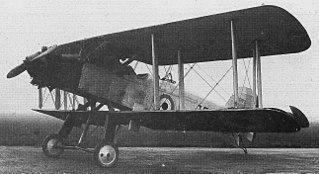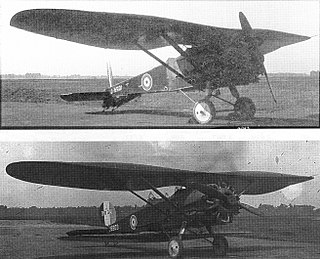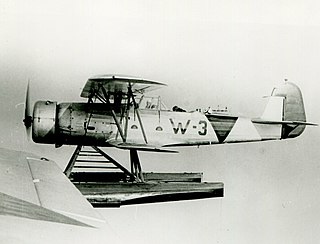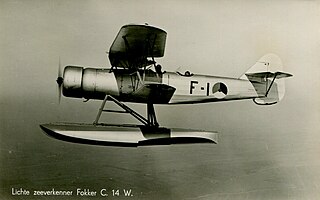
The Fokker E.I was the first fighter aircraft to enter service with the Fliegertruppe of the Deutsches Heer in World War I. Its arrival at the front in mid-1915 marked the start of a period known as the "Fokker Scourge" during which the E.I and its successors achieved a measure of air superiority over the Western Front.

The Fokker D.I was a development of the D.II fighter. The D.I was also flown in Austro-Hungarian service as a fighter trainer aircraft under the designation B.III. Confusing the matter further, both the D.II and D.I arrived at the Front in German service at similar times, in July–August 1916. The main designer was Martin Kreutzer.

The Short Springbok was a two-seat, all-metal reconnaissance biplane produced for the British Air Ministry in the 1920s. All together six aircraft of the Springbok design were built but none entered service with the armed forces.

The Armstrong Whitworth Wolf was a British two-seat reconnaissance aircraft ordered by the Royal Air Force in 1923.

The Avia BH-26 was a two-seat armed reconnaissance aircraft built in Czechoslovakia in 1927. It was a single-bay unstaggered biplane with equal-span wings and a fixed tailskid undercarriage. Both upper and lower wings featured long-span ailerons, which were dynamically balanced by a small auxiliary airfoil mounted to the upper surface of the lower ailerons. Its design was typical of this type of aircraft built during World War I and the years following; pilot and observer sat in tandem open cockpits with the observer armed with a machine gun on a ring mount. As with many other Avia designs, the BH-26 originally had no fixed fin, only a rudder, but this was changed in service.

The Fokker D.II was a German fighter biplane of World War I. It was a single-seat fighter aircraft developed before the Fokker D.I. It was based on the M.17 prototype, with single-bay unstaggered wings and a larger fuselage and shorter span than production D.IIs. Using a 75 kW (100 hp) Oberursel U.I, the D.II was underpowered, though the single 7.92 mm (.312 in) lMG 08 machine gun was normal for 1916. The German Army purchased 177.

The Bristol Bullfinch was an experimental British military aircraft first flown in 1922. Variants were built as both parasol wing monoplanes and biplanes, but both versions proved unsuccessful, and only the three prototypes were built.

The Fokker C.IV was a 1920s Dutch two-seat reconnaissance aircraft designed and built by Fokker.

The Fokker C.VIII was a reconnaissance aircraft built in the Netherlands in the late 1920s. Intended primarily for the photographic reconnaissance role, it was a larger machine than other Fokker reconnaissance types of the period, with space for a third crew member, who acted as camera operator. It was also Fokker's first aircraft of this type to be built as a monoplane, a parasol wing configuration. The construction, however, was in the familiar Fokker style with wooden wings covered with plywood and fabric, and a steel-tube fuselage, also fabric-covered.

The Fokker C.XI-W was a reconnaissance seaplane designed to operate from warships that was produced in the Netherlands in the mid-1930s. It was the result of a Royal Netherlands Navy specification of 1935 requesting such an aircraft. Fokker's response was a conventional single-bay biplane with staggered wings of unequal span braced by N-struts. The pilot and observer sat in tandem, open cockpits, and the undercarriage consisted of twin pontoons. The wings were of wooden construction with plywood and fabric covering, and the fuselage was of steel tube, also covered with fabric.

The Fokker CXIV-W was a reconnaissance seaplane produced in the Netherlands in the 1930s. It was a conventional, single-bay biplane with staggered wings of unequal span braced by N-struts. The pilot and observer sat in tandem, open cockpits, and the undercarriage consisted of twin pontoons. 11 of the 24 examples produced were stationed in the Dutch East Indies. These were later joined by 12 aircraft that had escaped to the UK following the German invasion of the Netherlands in 1940. All C.XIVs were destroyed during the Japanese invasion of the Dutch East Indies.

The Fokker D.XIII was a fighter aircraft produced in the Netherlands in the mid-1920s. It was a development of the Fokker D.XI with a new powerplant and considerably refined aerodynamics, and had been designed to meet the requirements of the clandestine flying school operated by the German Army at Lipetsk in the Soviet Union. Like its predecessor, it was a conventional single-bay sesquiplane with staggered wings braced by V-struts. The pilot sat in an open cockpit and the undercarriage was of fixed, tailskid type. The wings were made of wood and skinned with plywood, and the fuselage was built up of welded steel tube with fabric covering.

The Fokker D.XVI was a sesquiplane fighter aircraft developed in the Netherlands in the late 1920s.

The PWS-1 was a Polish two-seat fighter and reconnaissance aircraft constructed by Podlaska Wytwórnia Samolotów (PWS) in 1927. It remained a prototype for its entire lifespan.

The Hannover CL.II was an escort fighter, produced in Germany during World War I, designed in response to a 1917 requirement by the Idflieg for such a machine to protect reconnaissance aircraft over enemy territory. It was a compact biplane of largely conventional configuration with single-bay staggered wings of unequal span. The fuselage was a thin plywood paneled, wooden monocoque design, very similar to the style of fuselage in Robert Thelen's Albatros series of single-seat fighters.

The Mitsubishi Army Type 92 Reconnaissance Aircraft (九二式偵察機) was a Japanese short-range reconnaissance aircraft of the 1930s designed by Mitsubishi for the Imperial Japanese Army Air Force. A total of 230 were built, serving between 1933 and 1936. A parasol monoplane, the Type 92 was the first military aircraft powered by an engine both designed and manufactured in Japan to enter service.

The Fokker PW-5 was a Dutch fighter aircraft of the 1920s. It was a parasol monoplane of which twelve were built for the US Army Air Service, being used as advanced trainers.

The Hanriot HD.15 was a French two seat fighter aircraft fitted with a supercharger for good high altitude performance, built in the 1920s. Three were ordered by Japan but lost at sea during delivery.

The Wibault 10/II Tramontane was a two-seat reconnaissance aircraft designed and built by Société des Avions Michel Wibault in France for the French military 1923 A.2 competition for a 2-seater reconnaissance aircraft.
The Caproni Ca.134 was a biplane reconnaissance aircraft built by the Italian company Caproni in the 1930s.



















